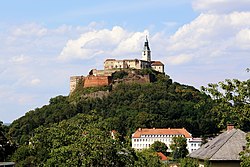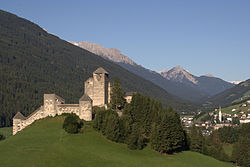History
In 1296, chronicles mention a castle called Trazperch standing at this location. It was destroyed by fire in 1490/91. Emperor Maximilian I left the ruin to the brothers Veit-Jakob and Simon Tänzl in exchange for Berneck Castle in Kaunertal in 1499. The Brothers Tänzel where commoners that came to money as part owners of the silver mine in Schwaz, and raised into nobility in 1502. Within 8 years, starting in 1500 a three-storey four-wing complex with courtyard and stair tower, portals and arcades, columns, window sills and fireplaces in Hagauer marble was built. The north wing remained unfinished to be completed later. The castle was sold by the heirs of the Tänzl brothers in 1553. The subsequent owner, Augsburg knight Georg von Ilsung finished the north wing and also the inner yards striking façade painting originate from this era. He and his family owned the castle for the second half of the 16th century and added the castles name to their family name. Georg's daughter Anna von Ilsung married Jakob III. Fugger. The wealthy Augsburg merchant family Fugger were also deeply involved in the local copper and silver mining businesses and inherited the castle in 1589. The Fuggerchamber and the Fuggerparlour are to this day visible reminder of this famous patrician family.
During the 17th and 18th century the castle underwent numerous changes of ownership and was owned by the noble families of Stauber-Imhof, Von der Halden and Josef Ignaz Reichsfreiherren (Barons of the Empire) of Tannenberg. In 1809, during the Napoleonic Wars, Bavarian soldiers looted the armoury and demolished part of the furniture.
In 1847 the castle was acquired by the Enzenberg Family by inheritance. They decided to restore the castle and made it their main residence. The castle is currently inhabited by Count Ulrich Goëss-Enzenberg and his wife Katrin Goëss-Enzenberg who induced further restorations. They also opened the castle to visitors and tourists.
Tourism and surroundings
The courtyard and the historic rooms of the 1st floor - can be visited from late March to early November as part of guided tours. The castle also features additional touristic infrastructure including, various parking lots, a transfer train a playground for children and a restaurant.
The castle is located on a wooded ridge on the slopes of the Karwendel and connected by significant hiking trails, leading to the pilgrimage destination St. Georgenberg-Fiecht Abbey, and to the natural reserves Wolfsklamm and Alpenpark Karwendel.
This page is based on this
Wikipedia article Text is available under the
CC BY-SA 4.0 license; additional terms may apply.
Images, videos and audio are available under their respective licenses.










